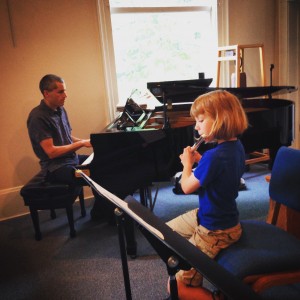Sight Reading Tips
- Marlene
- Blog, flute, Uncategorized
- No Comments
Sight Reading Tips
Sight Reading Tips and Three Activities for Improving Eye Tracking
I was teaching a lesson with a 9 year-old student this week when I asked her to do some sight reading. I noticed she was having a lot of trouble, starting and stopping frequently. The music I gave her wasn’t challenging so it seemed odd that she should have so much trouble with it. That’s when I started watching her eyes and I knew immediately what the problem was. Her eyes were focused on the note she was playing. When she came to the end of a line of music, her eyes made the jump to the next line at exactly the same time as her fingers.
When playing music, our eyes must be ahead of our fingers. The notes we are playing are not the notes we are looking at. This is an important skill for musicians.
Here are three things you can do to check and improve the eye movement:
- Teachers and Parents: Pay attention to where one line of music ends. As the student plays the music and approaches the end of the line, carefully watch her eyes. You should see her eyes jump to the left quickly as she begins reading the second line. Her eyes should move BEFORE she finishes playing the line of music. Depending on the tempo, the eyes will reach the second line as much as a measure before the fingers. Even at a slow tempo, the eyes will be at least one beat ahead of the fingers. Tracking the eye movements at the end of a line of music is the easiest way to diagnose the problem because the eyes must make a quick sweep from right to left. It’s easy to see the eyes move and measure if the jump is ahead of the sound.
- Teachers, here’s a game you can play during a lesson: As the student is playing, use a small piece of blank paper (a note card works well). Move the paper from left to right, covering up a note before the student plays it. The goal of this game is to help the student’s eyes track ahead of her fingers. Try covering up more of the music, perhaps two or three notes before she plays them. How fast you move the paper and how many you are able to cover ahead of the fingers depends on the speed of the music and the complexity of rhythms.
- Students: Practicing your sight reading may sound like an oxymoron, but it’s the best way to improve. I have found the Sight Reading Factory to be a very helpful subscription service. After selecting instrument, level, and length of exercise, the program generates new sight reading material. Best of all for our eye tracking purposes, you can choose “disappearing measures” as a challenge. As you play, the measures disappear, forcing you to look ahead. The way this program is designed, the measure will disappear after you play it. However, by watching the count-off and beginning two beats later, the measure will disappear just at the moment you begin to play it, forcing you to keep your eyes one measure ahead of the fingers.
It’s important that the eyes are tracking properly. Students whose eyes are focused on the current note will have a lot of difficulty sight-reading without frequent stops. The brain needs to have a head start to send the proper signals to the fingers.

No comments.